2003 VOLVO XC90 ECU
[x] Cancel search: ECUPage 137 of 242

2003 VOLVO XC90
fl. oz. (8.5 cl) of detergent to 2.6 US gal. (10 liters) of warm wat\
er. After washing with a detergent the
vehicle should be well rinsed with clean water.
Bumpers: Wash the bumpers with the same cleaning agent used on the rest of the v\
ehicle. Never clean
the bumpers with gasoline or paint thinner. Difficult spots can be remov\
ed with denatured alcohol. To
avoid scratches, do not dry the bumpers with paper.
NOTE: When washing the vehicle, remember to remove dirt from the drain holes i\
n the doors and sills. CAUTION
- During high pressure washing, the spray mouthpiece must never be close\
r to the vehicle than
13" (30 cm). Do not spray into the locks.
- When washing or steam cleaning the engine, avoid spraying water or ste\
am directly on the electrical
components or toward the rear side of the engine.
Special moonroof cautions:
- Always close the moonroof and visor before washing your vehicle.
- Never use abrasive cleaning agents on the moonroof.
- Never use wax on the rubber seals around the moonroof.
WARNING!
When the vehicle is driven immediately after being washed, apply the bra\
kes several times in order to
remove any moisture from the brake linings.
Engine cleaning agents should not be used when the engine is warm. This \
constitutes a fire risk.
pg. 111 Vehicle care
Automatic washing - simple and quick
l We do NOT recommend washing your vehicle in an automatic wash during the\
first six months
(because the paint will not have hardened sufficiently).
l An automatic wash is a simple and quick way to clean your vehicle, but i\
t is worth remembering that
it may not be as thorough as when you yourself go over the vehicle with \
sponge and water. Keeping the
underbody clean is most important, especially in the winter. Some automa\
tic washers do not have
facilities for washing the underbody.
l Before driving into an automatic car wash, make sure that side view mirr\
ors, auxiliary lamps, etc, are
secure, and that any antenna(s) are retracted or removed. Otherwise th\
ere is risk of the machine
dislodging them.
Polishing and Waxing
l Normally, polishing is not required during the first year after delivery\
, however, waxing may be
file:///K|/ownersdocs/2003/2003_XC90/03xc90_07.htm (2 of 5)12/30/2006 \
4:19:00 PM
Page 149 of 242

2003 VOLVO XC90
Returning the spare wheel to its storage compartment
NOTE: The space under the vehicle is designed to hold the special spare wheel \
only. Other fullsize
wheels will not fit in this compartment.
Returning the spare wheel to the storage compartment
1. Use the crank (turn it counterclockwise) to lower the spare wheel's\
retaining cable.
2. Pass the toggle at the end of the cable through the center hole in th\
e spare wheel. Pivot the toggle 90
degrees so that when raised, the wheel will rest on the toggle.
3. Retract the retaining cable slightly by slowly turning the crank cloc\
kwise several times.
4. Position the wheel so that it is not obstructed by components in the \
exhaust system.
5. Continue to raise the wheel by turning the crank clockwise.Raise the \
wheel a little bit at a time and
guide it around the rear axle until it is securely seated in the storage\
area.
6. When it is no longer possible to turn the crank any further, check th\
at the spare wheel is securely in
position in the storage compartment.
pg. 120 Wheels and tires
Jack attachment points
file:///K|/ownersdocs/2003/2003_XC90/03xc90_08.htm (9 of 12)12/30/2006\
4:19:01 PM
Page 167 of 242
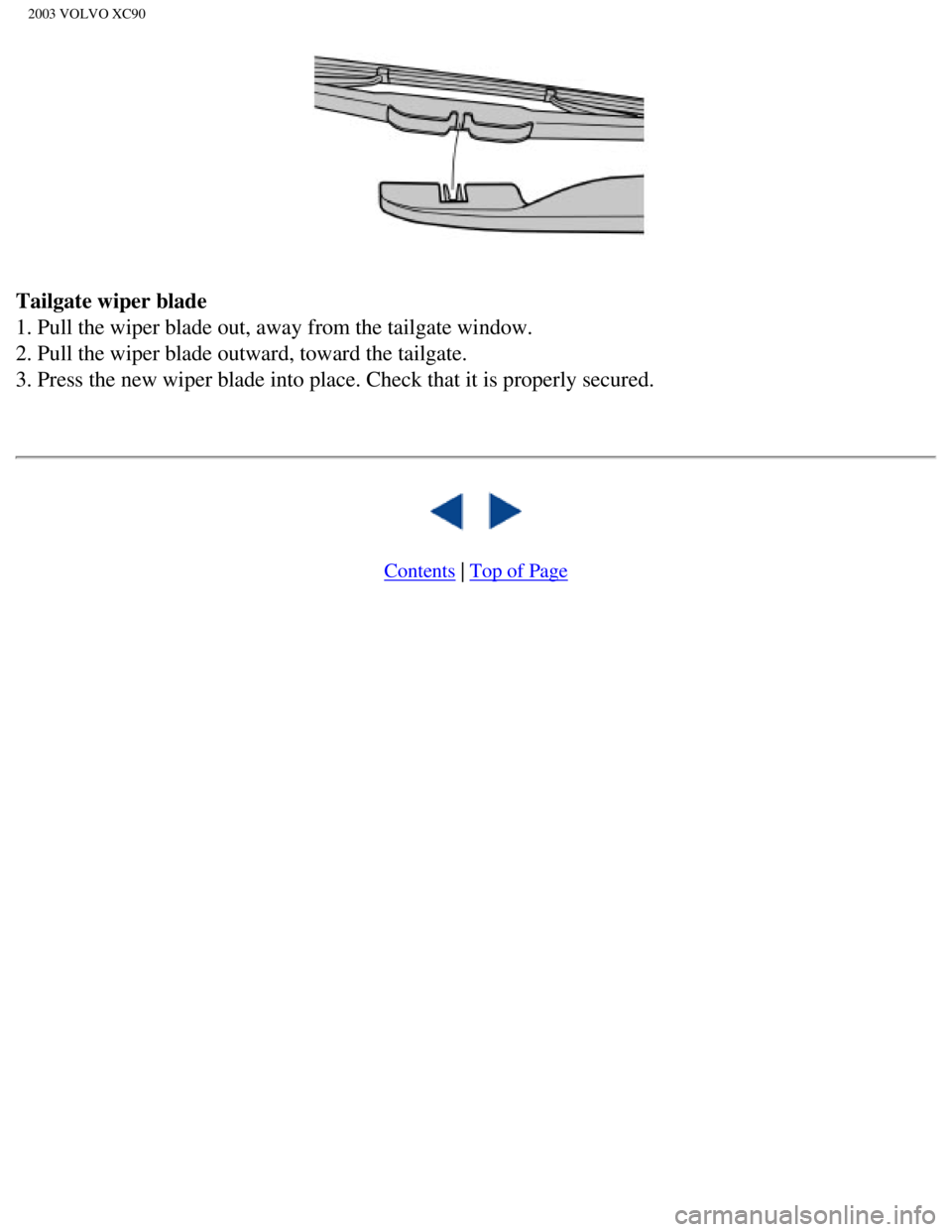
2003 VOLVO XC90
Tailgate wiper blade
1. Pull the wiper blade out, away from the tailgate window.
2. Pull the wiper blade outward, toward the tailgate.
3. Press the new wiper blade into place. Check that it is properly secur\
ed.
Contents | Top of Page
file:///K|/ownersdocs/2003/2003_XC90/03xc90_09a.htm (15 of 15)12/30/20\
06 4:19:02 PM
Page 168 of 242

2003 VOLVO XC90
pg. 134 Maintenance
Battery Maintenance
The battery in your vehicle is located under the floor of the cargo comp\
artment.
Driving habits and conditions, climate, the number of starts, etc. all a\
ffect the service life and function of
the battery. In order for your battery to perform satisfactorily, keep t\
he following in mind:
l Check the fluid level in each cell in the battery every 24 months or eve\
ry 15,000* miles (24,000 km),
whichever is sooner. The fluid should be at the level shown in the illus\
tration above (A)**.
l Use a screw driver to open the caps and a flashlight to inspect the leve\
l.
l If necessary, add distilled water. The level should never be above the i\
ndicator (A**).
l The fluid level should be checked if the battery has been recharged.
l After inspection, be sure the cap over each battery cell is securely in \
place.
l Check that the battery cables are correctly connected and properly tight\
ened. Route ventilation hose
through opening in floor (see
page 135)
l Never disconnect the battery when the engine is running, for example whe\
n changing the battery.
l The battery should be disconnected from the vehicle when a battery charg\
er is used directly on the
battery.
l However, if the battery is being charged via the connecting points in th\
e engine compartment (see
page 102), the battery must be connected.
* More frequently in warm climates.
** The level indicator inside the battery could be designed in various w\
ays. See illustration.
file:///K|/ownersdocs/2003/2003_XC90/03xc90_09b.htm (1 of 23)12/30/200\
6 4:19:04 PM
Page 170 of 242
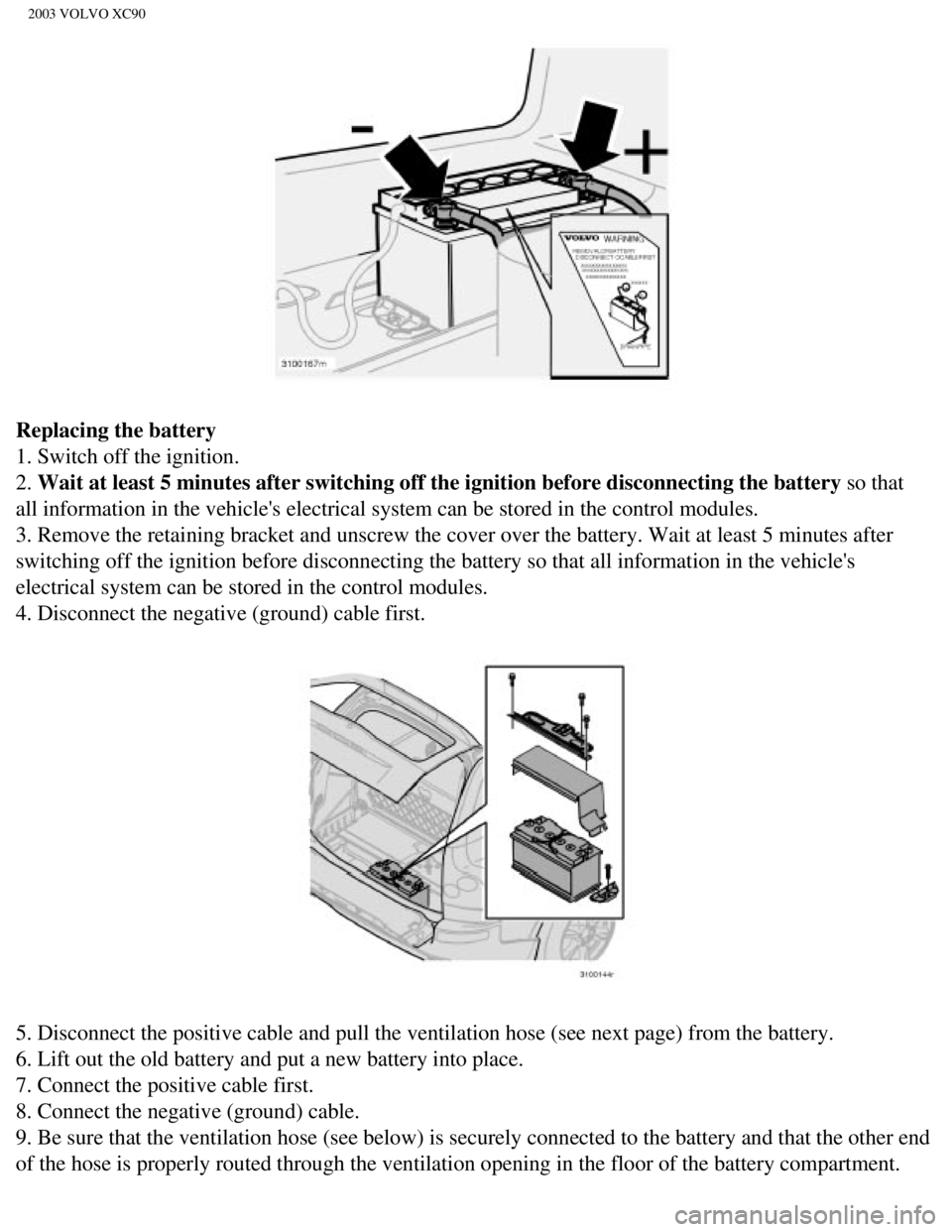
2003 VOLVO XC90
Replacing the battery
1. Switch off the ignition.
2. Wait at least 5 minutes after switching off the ignition before disconne\
cting the battery so that
all information in the vehicle's electrical system can be stored in the \
control modules.
3. Remove the retaining bracket and unscrew the cover over the battery. \
Wait at least 5 minutes after
switching off the ignition before disconnecting the battery so that all \
information in the vehicle's
electrical system can be stored in the control modules.
4. Disconnect the negative (ground) cable first.
5. Disconnect the positive cable and pull the ventilation hose (see nex\
t page) from the battery.
6. Lift out the old battery and put a new battery into place.
7. Connect the positive cable first.
8. Connect the negative (ground) cable.
9. Be sure that the ventilation hose (see below) is securely connected\
to the battery and that the other end
of the hose is properly routed through the ventilation opening in the fl\
oor of the battery compartment.
file:///K|/ownersdocs/2003/2003_XC90/03xc90_09b.htm (3 of 23)12/30/200\
6 4:19:04 PM
Page 171 of 242
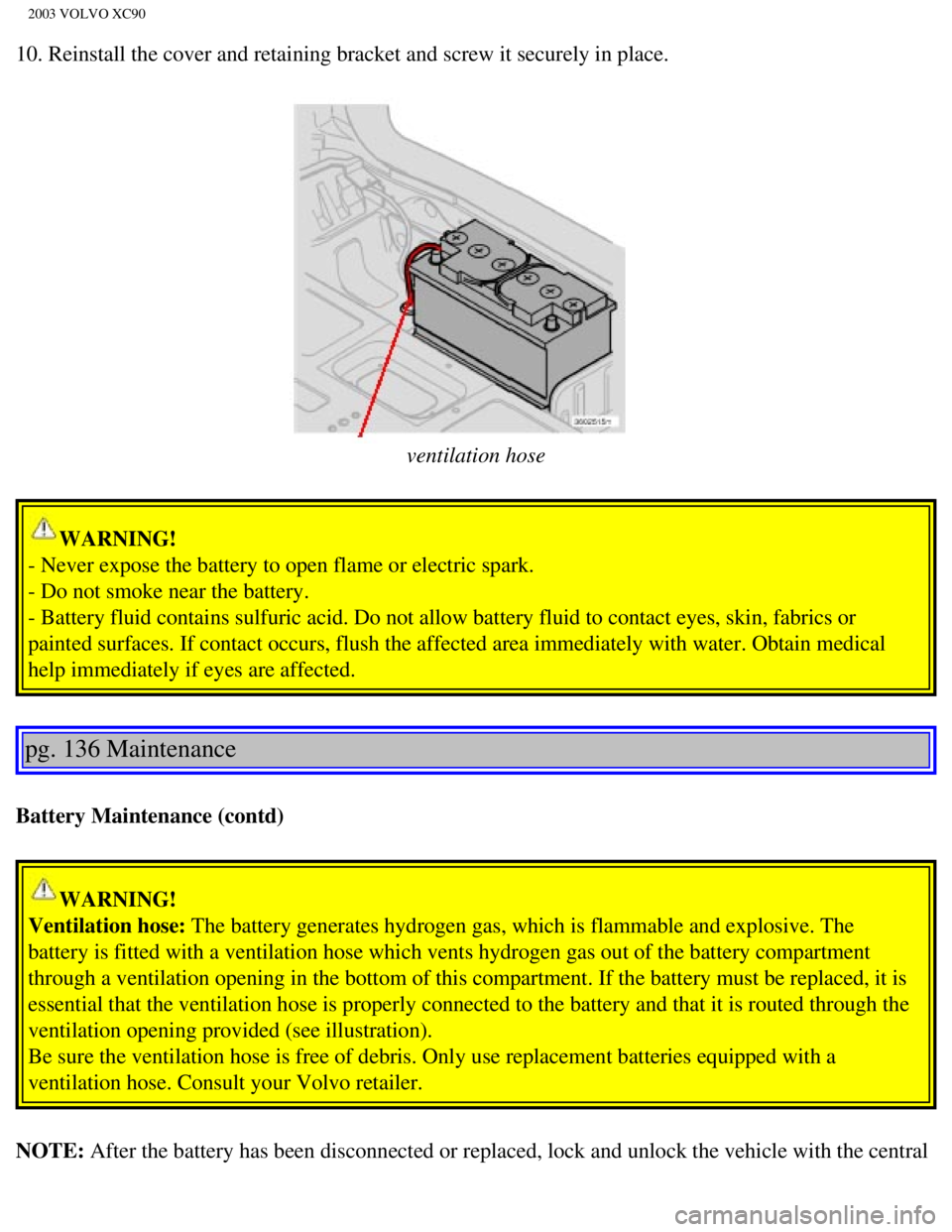
2003 VOLVO XC90
10. Reinstall the cover and retaining bracket and screw it securely in p\
lace.
ventilation hose
WARNING!
- Never expose the battery to open flame or electric spark.
- Do not smoke near the battery.
- Battery fluid contains sulfuric acid. Do not allow battery fluid to co\
ntact eyes, skin, fabrics or
painted surfaces. If contact occurs, flush the affected area immediately\
with water. Obtain medical
help immediately if eyes are affected.
pg. 136 Maintenance
Battery Maintenance (contd)
WARNING!
Ventilation hose: The battery generates hydrogen gas, which is flammable and explosive. T\
he
battery is fitted with a ventilation hose which vents hydrogen gas out o\
f the battery compartment
through a ventilation opening in the bottom of this compartment. If the \
battery must be replaced, it is
essential that the ventilation hose is properly connected to the battery\
and that it is routed through the
ventilation opening provided (see illustration).
Be sure the ventilation hose is free of debris. Only use replacement bat\
teries equipped with a
ventilation hose. Consult your Volvo retailer.
NOTE: After the battery has been disconnected or replaced, lock and unlock the\
vehicle with the central
file:///K|/ownersdocs/2003/2003_XC90/03xc90_09b.htm (4 of 23)12/30/200\
6 4:19:04 PM
Page 225 of 242
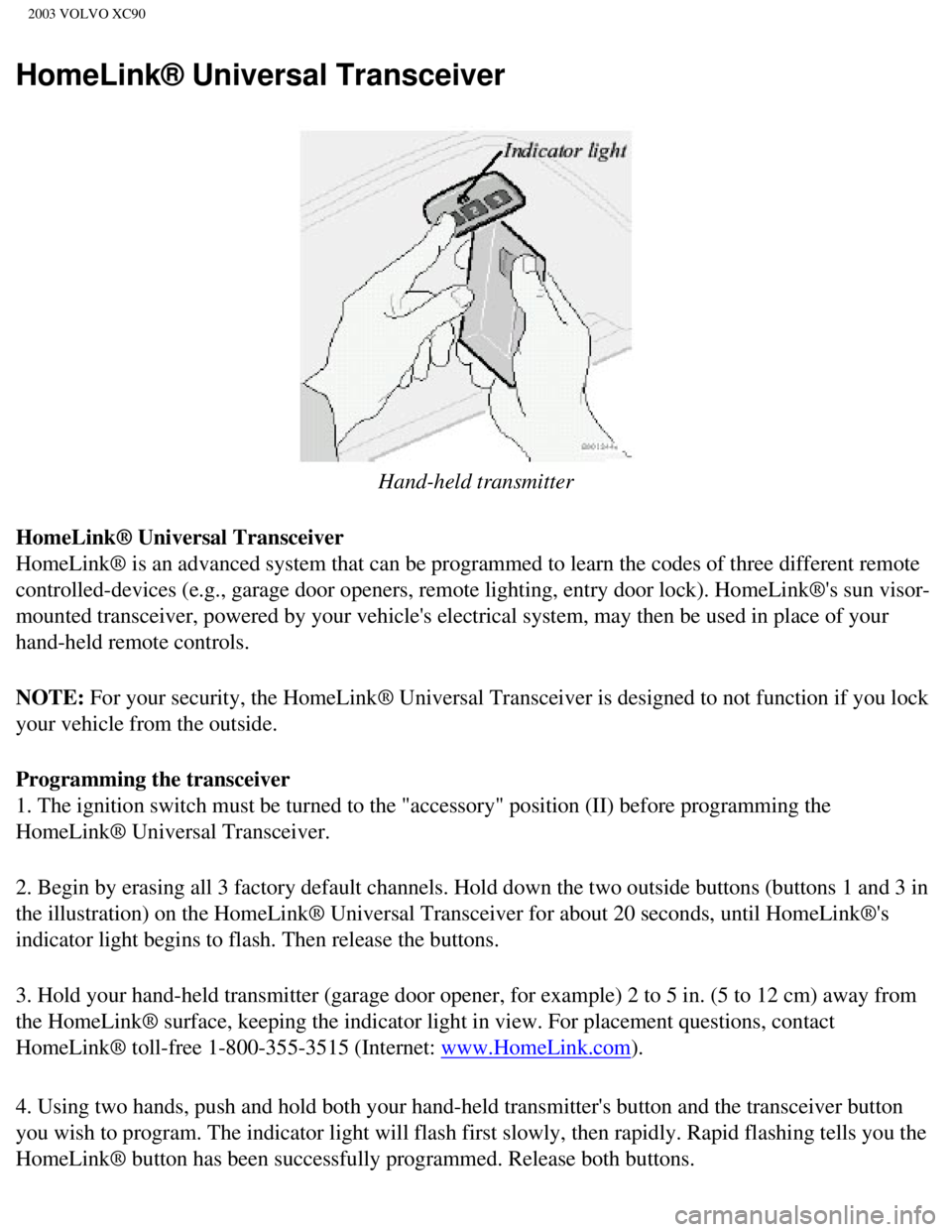
2003 VOLVO XC90
HomeLink® Universal Transceiver
Hand-held transmitter
HomeLink® Universal Transceiver
HomeLink® is an advanced system that can be programmed to learn the c\
odes of three different remote
controlled-devices (e.g., garage door openers, remote lighting, entry d\
oor lock). HomeLink®'s sun visor-
mounted transceiver, powered by your vehicle's electrical system, may th\
en be used in place of your
hand-held remote controls.
NOTE: For your security, the HomeLink® Universal Transceiver is designed to\
not function if you lock
your vehicle from the outside.
Programming the transceiver
1. The ignition switch must be turned to the "accessory" position (II)\
before programming the
HomeLink® Universal Transceiver.
2. Begin by erasing all 3 factory default channels. Hold down the two ou\
tside buttons (buttons 1 and 3 in
the illustration) on the HomeLink® Universal Transceiver for about 2\
0 seconds, until HomeLink®'s
indicator light begins to flash. Then release the buttons.
3. Hold your hand-held transmitter (garage door opener, for example) 2\
to 5 in. (5 to 12 cm) away from
the HomeLink® surface, keeping the indicator light in view. For place\
ment questions, contact
HomeLink® toll-free 1-800-355-3515 (Internet:
www.HomeLink.com).
4. Using two hands, push and hold both your hand-held transmitter's butt\
on and the transceiver button
you wish to program. The indicator light will flash first slowly, then r\
apidly. Rapid flashing tells you the
HomeLink® button has been successfully programmed. Release both butto\
ns.
file:///K|/ownersdocs/2003/2003_XC90/03xc90_11b.htm (8 of 11)12/30/200\
6 4:19:07 PM
Page 227 of 242
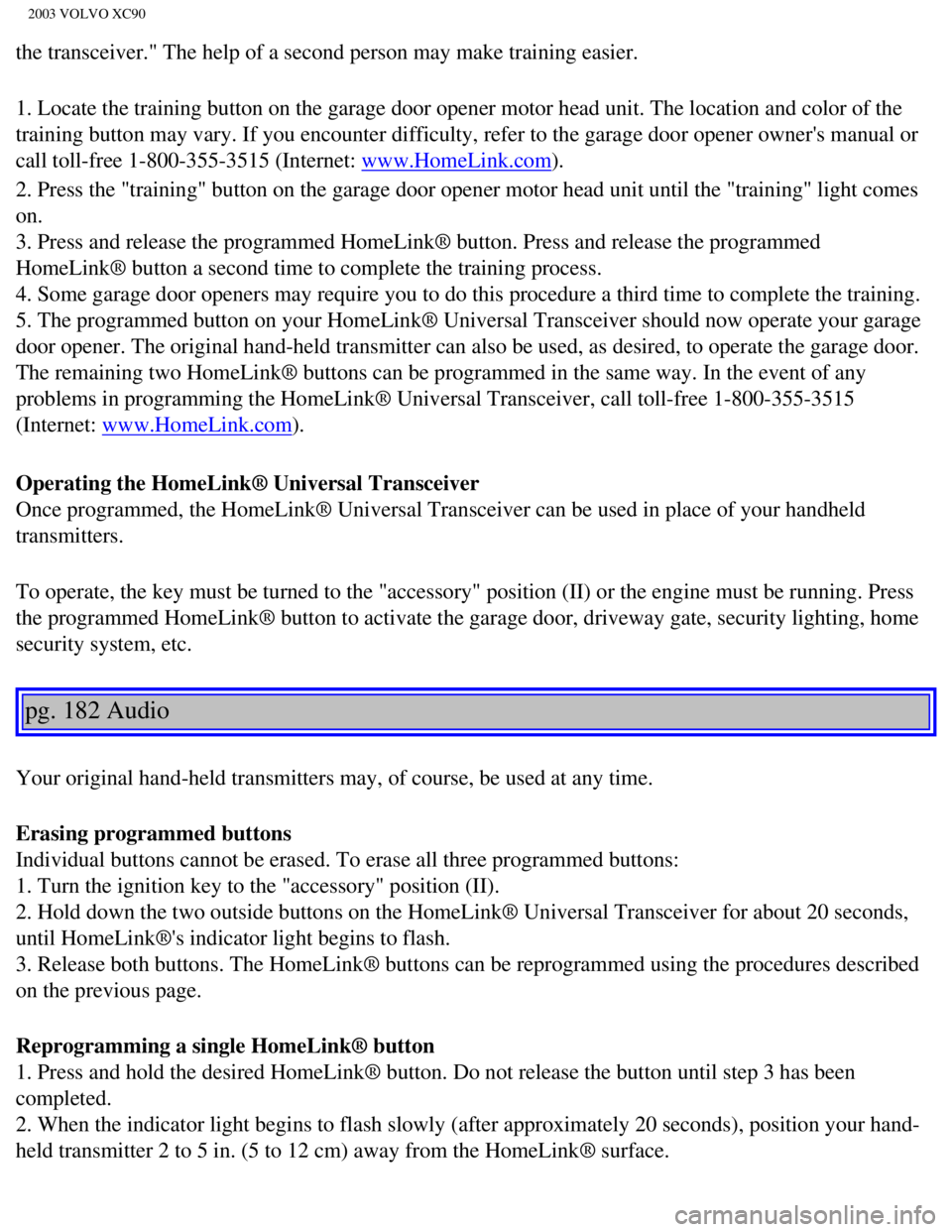
2003 VOLVO XC90
the transceiver." The help of a second person may make training easier.
1. Locate the training button on the garage door opener motor head unit.\
The location and color of the
training button may vary. If you encounter difficulty, refer to the gara\
ge door opener owner's manual or
call toll-free 1-800-355-3515 (Internet:
www.HomeLink.com).
2. Press the "training" button on the garage door opener motor head unit\
until the "training" light comes
on.
3. Press and release the programmed HomeLink® button. Press and relea\
se the programmed
HomeLink® button a second time to complete the training process.
4. Some garage door openers may require you to do this procedure a third\
time to complete the training.
5. The programmed button on your HomeLink® Universal Transceiver shou\
ld now operate your garage
door opener. The original hand-held transmitter can also be used, as des\
ired, to operate the garage door.
The remaining two HomeLink® buttons can be programmed in the same way\
. In the event of any
problems in programming the HomeLink® Universal Transceiver, call tol\
l-free 1-800-355-3515
(Internet:
www.HomeLink.com).
Operating the HomeLink® Universal Transceiver
Once programmed, the HomeLink® Universal Transceiver can be used in p\
lace of your handheld
transmitters.
To operate, the key must be turned to the "accessory" position (II) or\
the engine must be running. Press
the programmed HomeLink® button to activate the garage door, driveway\
gate, security lighting, home
security system, etc.
pg. 182 Audio
Your original hand-held transmitters may, of course, be used at any time\
.
Erasing programmed buttons
Individual buttons cannot be erased. To erase all three programmed butto\
ns:
1. Turn the ignition key to the "accessory" position (II).
2. Hold down the two outside buttons on the HomeLink® Universal Trans\
ceiver for about 20 seconds,
until HomeLink®'s indicator light begins to flash.
3. Release both buttons. The HomeLink® buttons can be reprogrammed us\
ing the procedures described
on the previous page.
Reprogramming a single HomeLink® button
1. Press and hold the desired HomeLink® button. Do not release the bu\
tton until step 3 has been
completed.
2. When the indicator light begins to flash slowly (after approximately\
20 seconds), position your hand-
held transmitter 2 to 5 in. (5 to 12 cm) away from the HomeLink® su\
rface.
file:///K|/ownersdocs/2003/2003_XC90/03xc90_11b.htm (10 of 11)12/30/20\
06 4:19:07 PM